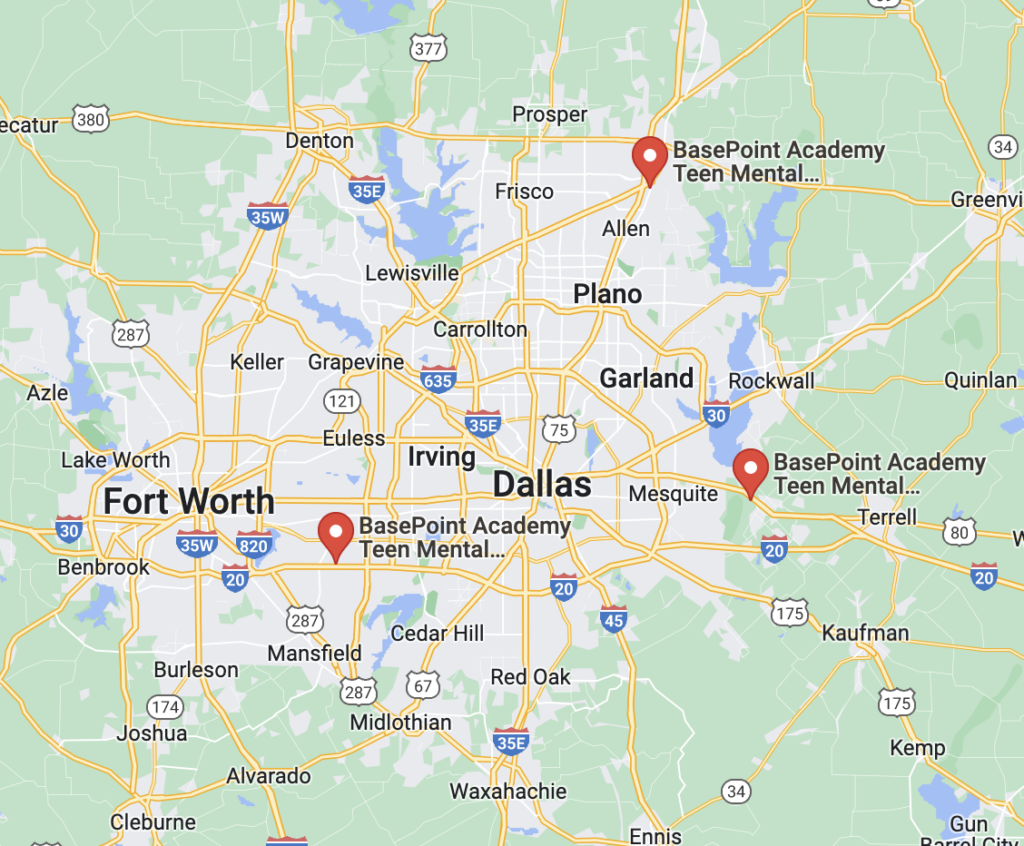Online Cutting and Self-Harm Treatment for Teens in Texas
Rates of Non-Suicidal Self-Injury (NSSI) range from approximately 7% to 24% among early to older adolescents. If your teen is engaging in self-inflicted harm, you’re not alone, and support is available. BasePoint Academy’s online treatment services have successfully improved teenage well-being while instilling healthier coping skills. This page puts a spotlight on online self-harm treatment for teens in Texas.
What Is Cutting and Self-Harm?
If you’re a parent whose teen is self-harming, you’re likely feeling heartbroken, scared, and unsure of what to do next. These behaviors—cutting, scratching, burning, or related—can look like a cry for attention on the surface, but they’re usually a silent scream for help.
For many teenagers, self-harm isn’t about wanting to end their life. It’s about trying to escape emotional pain they can’t explain verbally and using physical pain to feel some sense of control or release. Self-harming coping mechanisms are often used to manage overwhelming emotions when teens feel unable to express their pain in healthier ways. Still, these coping mechanisms are dangerous.
Beyond the physical risks—like infections, self-harm scars, or even life-threatening injuries—self-harm can trap your teen in a damaging emotional loop. It often leads to feelings of guilt, shame, and isolation, only making the distress they’re already feeling even harder to carry. If your teen is engaging in self-harming behavior, don’t hesitate to call BasePoint Academy for immediate support.
Teen Virtual Cutting and Self-Harm Treatment
Our complimentary assessment with a licensed clinician will provide you with a recommendation for the appropriate virtual treatment plan for your teen struggling with cutting or self-harm. We can also check your insurance coverage levels.
Call us today to schedule a complimentary same-day assessment at (972) 357-1749 or complete our inquiry form.
Find Out About Our Admissions
What Are the Signs and Symptoms of Cutting and Self-Harm in My Teen Child?
If you’re worried your teen may be engaging in self-harming behaviors like cutting, it’s essential to trust your instincts and gently explore what’s happening beneath the surface. Many teens who self-harm do so in private and often go to great lengths to hide the signs, but that doesn’t mean you’re powerless to help.
Simply noticing that something seems off is already a vital first step. Self-inflicted harm can be a way for teens to cope with intense emotions, mental health struggles, or internal stress they don’t know how to express. By learning what to look for, you can better support your child with care, compassion, and early intervention. The following are a few common signs and symptoms of cutting and self-harm in adolescents.
Finding Sharp Objects in Strange Places
If you’ve started noticing razors, safety pins, or other sharp objects hidden in unexpected places—like under your teen’s mattress, tucked in drawers, or stashed in bags—it could be a warning sign of self-harming behavior. Teens who are struggling may keep these items nearby to cope with emotional pain they don’t yet know how to talk about.
Mood Swings or Irritability
Frequent emotional ups and downs or sudden irritability might seem like typical adolescent behavior, but if it’s extreme or persistent, it could signal something deeper. Teens who self-harm often feel overwhelmed by emotions and may lash out or withdraw as a way to manage what they’re feeling inside.
Feeling Bad about Oneself
When a teen constantly puts themselves down, says things like “I’m not good enough,” or shows signs of profound shame, it can reflect the emotional distress that often leads to self-harming impulses and behaviors. These thoughts can weigh heavily, pushing your child to cope in unhealthy and dangerous ways.
Spending Lots of Time Alone
If your child increasingly isolates themselves, spends more time behind closed doors, or avoids family and friends, it may be more than just needing space. Many teens who self-harm retreat into solitude because they feel misunderstood, ashamed, or emotionally overwhelmed.
Struggling with Emotions
Teens who self-harm often have a tough time identifying or expressing what they’re feeling. They may seem overwhelmed by sadness, anger, or anxiety, but can’t find the words to say what’s wrong. This emotional bottling can lead them to seek physical outlets like cutting to feel a sense of control or release.
Doing Things without Thinking
Impulsive decisions or risky behavior—like sneaking out, acting recklessly, or lashing out—can be tied to emotional distress. Some teens turn to self-harm in moments of impulsivity, especially when they feel they’ve run out of other ways to manage the pain or chaos inside.
Cuts, Scratches, Bruises, or Burns on the Body
Unexplained marks on your teen’s arms, legs, or torso—especially when they appear repeatedly or seem hidden under clothing—can be a serious sign of self-injury. Your teen may go to great lengths to hide these wounds, so gentle observation and communication are essential.
Talking About Self-Harm or Suicide
If your child is making comments about wanting to hurt themselves or expressing thoughts of hopelessness, even in passing, it’s something to take seriously. Sometimes, teens drop hints because they don’t know how to ask for help outright. Let them know you’re listening—and that you sincerely care.
Wearing Clothes to Hide Injuries
Wearing long sleeves in hot weather or layers that don’t match the season might be your teen’s way of covering up self-inflicted wounds. If this shift in clothing habits seems unusual or out of character, it could be a sign that they’re trying to hide physical evidence of emotional pain.
Info and Statistics on Teen Cutting and Self-Harm for Families in Texas
Research paints a concerning picture when it comes to self-harm among youth. A study from the Texas Youth Depression and Suicide Research Network revealed that nearly one in ten teens reported engaging in Non-Suicidal Self-Injury (NSSI). A year-long community study published in BMC Psychiatry found that 27% of young adolescents had thoughts of self-harm, while 15% acted on those thoughts.
Particularly vulnerable are ninth-grade girls, who engage in NSSI at three times the rate of boys, as found in a 2012 study. The behaviors also vary based on age and gender. More recently, a 2023 nationwide study of 37,268 adolescents highlighted the connection between social media and self-harm, with 16.1% reporting self-harm in the past year—22.5% of girls and 9.5% of boys. Mental Health America notes that self-injury often begins between ages 12 and 14, typically to cope with intense feelings of sadness, anxiety, or confusion. These findings underscore the urgent need for greater awareness and support for teens struggling with self-harming behaviors.
Contact BasePoint Academy Today
Contact us today to schedule a free confidential assessment for your teen with a licensed clinician.
You can also get in touch to talk with our mental health experts about treatment needs, care options and your insurance coverage levels.
Call: (972) 357-1749Check Your InsuranceCommon Causes of Self-Harm Among Texas Teenagers
If your child is engaging in self-destructive behavior, you’re likely feeling overwhelmed, heartbroken, and desperate to understand why. You’re not alone—and your concerns are valid. It’s important to know that the reasons behind self-harm vary from teen to teen, but below are some of the more common causes. This is by no means a complete list.
Relationship Difficulties
Tension with friends, romantic partners, or family members can leave teens emotionally stranded. If your child is struggling with breakups, family conflict, or social rejection, those intense emotions can become too much to handle. In these moments, self-hurt might feel like the sole outlet they have to process their pain or regain a sense of control.
Academic or Performance Pressure
Whether it’s pressure to earn straight A’s, excel in sports, or meet high expectations, many teens feel crushed by the weight of performance standards. If your child is putting extreme pressure on themselves to succeed or feels like they’re constantly falling short, those internal battles can contribute to self-harming tendencies as a misguided form of release or punishment.
Bullying or Harassment
Facing constant criticism, exclusion, or online harassment can take a serious toll on your teen’s emotional well-being. Whether it’s happening in person or through social media, bullying can lead to feelings of worthlessness and isolation. When these feelings become unbearable, some teens resort to self-destructive behavior to express their pain or numb their emotional suffering.
Mental Health Disorders
Conditions like depression, anxiety, borderline personality disorder, and PTSD often go together with self-harming patterns. If your teen is dealing with a mental health disorder or co-occurring disorders, they may not have the emotional tools to cope with the intensity of their symptoms. This unknown territory can make self-injury feel like the only way to manage what they’re feeling inside.
Emotional Distress
Sometimes, teenagers don’t know how to put their pain into words—they just know it hurts. Emotional distress, especially when left unspoken or invalidated, can build up until it spills out through self-injurious behaviors. This can happen after a major disappointment, ongoing stress, or even subtle but chronic feelings of not being good enough.
Trauma or Abuse
If your teen has experienced trauma or abuse, the emotional aftermath can manifest in many forms—including self-abuse. Whether it’s physical, emotional, or sexual abuse, the internal damage often leads to deep shame, numbness, or a need to externalize emotional pain through physical means. These experiences can have lasting effects if left unaddressed.
Peer Pressure
Some teens begin self-harming because they’ve seen others do it or feel pressure to be part of a group that normalizes or even romanticizes the behavior. What may start as curiosity or imitation can quickly evolve into dangerous self-harming patterns. If your teen is surrounded by peers who engage in or talk openly about self-harm, they may participate themselves.
Identity and Self-Image Issues
Adolescence is a time of intense self-discovery, and for teens who are questioning their identity, struggling with body image, or facing rejection for who they are, the pressure can be immense. These struggles can trigger self-harming impulses and behaviors to cope with feelings of confusion, rejection, or self-hatred.
Does Private Health Insurance Cover Online Self-Harm Treatment for Teens in Texas?
Yes, many private health insurance plans in Texas do cover online self-harm treatment for teens, including video conferencing therapy sessions and intensive outpatient programs. Coverage can vary based on your policy, but more insurers recognize the value and effectiveness of teletherapy and other online mental wellness services.
If your child struggles with self-injurious behaviors, exploring your private health insurance benefits can be a helpful first step in accessing care. Virtual mental health care can offer consistent, confidential support that meets your teen where they are—both emotionally and physically. Don’t hesitate to contact your insurer or a treatment center specializing in adolescent care, like BasePoint Academy. We can conduct a free self-harm assessment for teens that will allow our experienced professionals to provide treatment recommendations based on their unique needs. Call BasePoint Academy now!

Which Health Insurance Providers Cover Virtual Self-Harm Treatment in Texas?
Many major health insurance providers in Texas offer coverage for virtual self-harm treatment for teens. Plans through companies like Blue Cross Blue Shield of Texas, Aetna, Cigna, UnitedHealthcare, and Humana often include access to telepsychology services and programs. Online treatment can be essential in helping your child manage self-harming habits in a safe and supportive environment.
If you’re concerned about your teen’s emotional well-being or have noticed self-inflicted wounds, knowing that your insurance may help cover online treatment options can bring some relief. Digital therapy sessions allow your child to receive personalized, remote emotional support without the stress of traveling and other logistics. Confirm coverage details and utilize in-network virtual mental health care options to maximize your benefits.
Online Virtual Programs for Self-Harm in Texas
Watching your child struggle with self-harming behavior can be one of the most painful and helpless experiences imaginable. You may feel unsure of where to turn or how to find the right kind of help, especially if your teen resists traditional, in-person therapy.
Thankfully, virtual self-harm treatment for teens is now more accessible than ever in Texas, offering a lifeline when your family needs it most. Through digital mental health services, your teen can receive professional care, guidance, and remote emotional support from the comfort and privacy of home. Contact BasePoint Academy for more information on our web-based mental health support programs.
Online PHP for Teen Self-Harm
If your teen needs more structured support but isn’t ready for inpatient care, an online Partial Hospitalization Program (PHP) can provide the intensive help they need right from home. These programs offer internet-based therapy focused on replacing self-injurious actions with healthier ways to cope while allowing your child to sleep in their bed and stay connected to family.
Online IOP for Teen Self-Harm
An Intensive Outpatient Program (IOP) delivered through telebehavioral health services can be a decisive step toward healing for your teen. This form of online psychiatric help offers flexible scheduling, evidence-based care, and consistent therapeutic support—all while helping your child manage self-damaging behaviors in a familiar and supportive environment.
Online Group Therapy for Teens Who Self-Harm
Sometimes, the most healing words come from someone who truly understands. Online group therapy for teens who self-harm creates a safe space where your child can connect with peers facing similar struggles. These sessions combine professional guidance with peer support to make online therapy for self-harming feel less isolating and more hopeful.
Online Psychotherapy and Counseling Services for Self-Harming Teens
Remote psychotherapy and virtual counseling allow your teen to speak openly and honestly with a licensed therapist without ever leaving home. These one-on-one internet therapy sessions explore the emotions behind self-harming tendencies, help your teen build emotional resilience, and equip them with healthier tools to navigate their world.

BasePoint Academy Accepts health Insurance
We accept most major health insurance providers in Texas and can check your treatment coverage levels on your behalf
Virtual Cutting and Self-Harm Treatment Program for Teens in Texas
BasePoint Academy offers compassionate, expert-led care for teens who are struggling with self-harm, including those engaging in self-cutting. With multiple facilities in and around Dallas, Texas, we combine clinical expertise with a specialized understanding of what teens and their families are going through.
If your teen shows signs of self-cutting or other self-injurious behaviors, you don’t have to face this difficult chapter alone. Our online self-harm cutting treatment for teens offers structured emotional support, therapeutic tools, and personalized guidance from licensed professionals—all without the need to travel. We’re here to help your child find safer ways to cope and heal.
- Arlington, Texas: 3900 Arlington Highlands Blvd, Suite 237, Arlington, TX 76018
- Forney, Texas: 713 W Broad St, Suite 200, Forney, TX 75126
- Frisco, Texas: 8275 Judges Way, Suite 100I, Frisco, TX 75036
- McKinney, Texas: 4733 Medical Center Drive, McKinney, TX 75069

Virtual Self-Harm Treatment Programs Via Arlington, Texas
Arlington, Texas, between Dallas and Fort Worth, is known for its family-friendly neighborhoods, educational institutions, and rich cultural scene. When seeking compassionate care for a teen struggling with self-harming behaviors, Arlington is home to BasePoint Academy, a trusted provider of adolescent mental health services delivered straight to your home.
- BasePoint Academy- Arlington, Texas: 3900 Arlington Highlands Blvd, Suite 237, Arlington, TX 76018, United States
Virtual Self-Harm Treatment Programs Via Forney, Texas
Located just east of Dallas, Forney, Texas, offers a close-knit community feel with easy access to urban resources. It’s a growing city where you and your teen can find peace and opportunity. It’s also home to our Forney location, which provides in-person and digital mental health services for convenient, quality care.
- BasePoint Academy – Forney, Texas: 713 W Broad St, Suite 200, Forney, TX 75126, United States
Virtual Self-Harm Treatment Programs Via McKinney, Texas
McKinney, Texas, is known for its historic charm, welcoming neighborhoods, and focus on community wellness. Families in the Lone Star State can turn to BasePoint Academy for high-quality mental health care tailored to teens. Our online self-harm treatment helps teens manage self-harming tendencies while providing therapy and support from licensed professionals.
- BasePoint Academy – McKinney, Texas: 4733 Medical Center Drive, McKinney, TX 75069, United States
Virtual Self-Harm Treatment Programs Via Frisco, Texas
Frisco, Texas, is a rapidly growing city known for its innovation, excellent schools, and dedication to family life. For meaningful mental health support, BasePoint Academy provides a trusted option. Our virtual self-harm treatment programs offer a safe, structured space to explore teenage emotions, build healthier coping skills, and break the cycle of self-injurious behavior—all from the privacy of home.
- BasePoint Academy – Frisco, Texas: 8275 Judges Way Suite 100F, Frisco, TX 75036
Alternative Ways to Find Virtual Self-Harm Management Programs in Texas
If you’re a parent in Texas trying to find the most fitting virtual self-harm management program for your struggling teen, you’re not alone, and there are accessible, compassionate options out there. Whether you’re just starting to explore online treatment or homing in on your options, there are several reliable paths to connect you with the support your child needs.
To find reputable online therapy for self-harming near you, you can follow these steps:
- Online Search: Use search engines to explore treatment centers specializing in teen self-harm in Texas. Enter terms like “online self-harm treatment for teens in Dallas, Texas” or “telemental health solutions for self-harming teens near me.”
- E-therapy Platforms: Check out online treatment platforms like Rula, Talkspace, and BetterHelp. These specifically offer online mental wellness services and can often be used to filter by specialty like ‘adolescent care’ and ‘self-harming behavior.’
- Referrals: Contact your child’s pediatrician, school counselor, or a trusted therapist for referrals. These professionals often know local or statewide programs that provide remote emotional support or telehealth counseling for teens.
- Insurance Provider: If you have private insurance, call or visit your provider’s website to find in-network virtual self-harm management programs. Ask specifically about online treatment programs that address teen cutting or self-harming patterns.
- Local Mental Health Organizations: Texas has many community-based mental health resources. Organizations in the Dallas area, in particular, may offer connections to virtual self-harm treatment for teens or can point you toward specialists with experience in helping teenagers manage emotional pain safely.
- Online Reviews and Testimonials: Once you find a few potential programs or providers, take a moment to look through reviews or testimonials from other families. First-hand experiences can help you decide if a therapist or online program is the right fit.
- Contact and Consultation: Many centers offer free phone consultations or virtual meet-and-greets. This is an excellent opportunity to ask about their approach, what a typical internet-based therapy session entails, how they address self-harming habits, and how they involve you as a parent in the healing process.
Contact BasePoint Academy Today
Contact us today to schedule a free confidential assessment for your teen with a licensed clinician.
You can also get in touch to talk with our mental health experts about treatment needs, care options and your insurance coverage levels.
Call: (972) 357-1749Check Your InsuranceMost Common Forms of Self-Harm in a Teen Child
When you’re worried your teen may be self-harming, it can feel like you’re trying to understand a language you were never taught. Self-harming behaviors often come in many forms; not all are immediately obvious. Recognizing the most common methods your child might use is a first step toward offering the support and care they need.
Below are some behaviors (not all) that may be signs your teen is in emotional distress.
Scratching
Some teens turn to repeated scratching—often with fingernails, pins, or other objects—to release emotional pain. These scratches might seem minor initially, but they’re usually done with intention and in areas they try to hide.
Biting
Self-inflicted biting may leave noticeable marks or bruises on your teen’s arms, hands, or shoulders. This method of self-harm can be a physical expression of overwhelming emotions, especially when your child is struggling to cope or communicate their deep-seated pain.
Hair Pulling (Trichotillomania)
Pulling out hair from the scalp, eyebrows, or eyelashes may be your teen’s way of managing anxiety or emotional overload. While it may not always be connected to intentional self-injury, it often overlaps with emotional distress that needs compassionate attention.
Cutting
Cutting is one of the most recognized and common forms of self-harm. It typically involves using sharp objects to create small wounds on the skin, most often on the arms, thighs, or stomach. For some teens, it becomes a way to feel in control or to externalize pain they can’t express otherwise.
Burning
Using lighters, matches, or heated objects to burn the skin can be a way your teen is trying to manage deep emotional hurt. Burns may appear in unusual patterns or be in places typically covered by clothing to avoid detection.
Ingesting Harmful Substances
Some teenagers may swallow things they know are harmful—like chemicals, medications, or non-food objects—as a form of self-punishment or escape. This type of self-harm can be hazardous and often requires urgent medical attention and emotional support.
Hitting or Punching Oneself
You might notice unexplained bruises or soreness if your child is hitting themselves or punching hard surfaces. This type of self-harm is often fueled by intense anger, shame, or frustration stemming from an inability or know-how to manage in healthier ways.
Interfering with Wound Healing
Some teens repeatedly pick at scabs or intentionally prevent cuts from healing. It may be a continuation of the initial self-damaging behavior or a way to regain control. These self-inflicted wounds can signal ongoing emotional distress that needs immediate and gentle intervention.
How Much Does Online Teen Self-Harm Treatment Cost in Texas?
In Texas, the cost of online teen self-harm treatment can vary widely depending on the provider, level of care, and whether you’re using insurance. Some teletherapy sessions might involve an average copay between $30 and $80 per session, while programs that include more intensive online support may charge daily, monthly, or bundled rates.
The good news is that many e-therapy platforms and virtual mental health programs accept insurance, which can significantly lower out-of-pocket costs. If you have private insurance, it’s worth checking with your insurer to see what services are covered, especially for online self-harm treatment for teens. Some programs may also offer financial assistance or sliding scale fees. No matter your budget, options are available to help your teen heal safely and privately from the comfort of home. At BasePoint, we’re happy to confirm the details of your insurance policy as they relate to your teen’s treatment needs or answer any questions regarding the cost of online mental health treatment—call (972) 357-1749 today.
Guide to Culturally Competent Teen Treatment in Texas
Statistics on Teen Self-Inflicted Harm and Self-Destructive Behavior for Texas Families
- According to research from the Texas Youth Depression and Suicide Research Network (TX-YDSRN), nearly one in ten young people reported taking part in Non-Suicidal Self-Injury (NSSI).
- A community-based study published in BMC Psychiatry found that over one year, 27% of young adolescents reported having thoughts of self-harm, and 15% reported engaging in at least one act of self-harm. Among those who did self-harm, fewer than one in five (18%) had reached out for help with anxiety or depression.
- A 2012 study found that ninth-grade girls are especially at risk, engaging in Non-Suicidal Self-Injury (NSSI) at three times the rate of boys. The ways teens engage in NSSI also tend to differ based on both grade level and gender.
- In a 2023 nationwide study involving 37,268 adolescents exploring the link between social media use and self-harm, 16.1% reported engaging in self-harm within the past year. The findings showed a notable gender difference, with 22.5% of girls reporting self-harm compared to 9.5% of boys.
- According to Mental Health America (MHA), self-injury typically starts between the ages of 12 and 14 and is often driven by overwhelming emotions such as sadness, anxiety, distress, or confusion.
Get Effective Online Teen Mental Health Treatment at BasePoint Academy
We can help your teen and your family address and improve self-harm habits with online treatment in a safe environment. Call today to discover the treatment for long-term healing.






